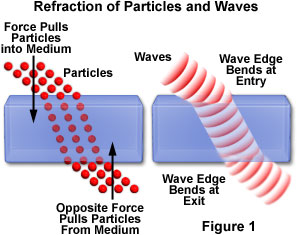Interactive Tutorials
Particle and Wave Refraction
One point of view envisions light as wave-like in nature, producing energy that traverses through space in a manner similar to the ripples spreading across the surface of a still pond after being disturbed by a dropped rock. The opposing view holds that light is composed of a steady stream of particles, much like tiny droplets of water sprayed from a garden hose nozzle. This interactive tutorial explores how particles and waves behave when refracted through a transparent surface.
The tutorial initializes with particles of monochromatic red light (photons) impacting the surface of a glass block with an incident angle of approximately 30 degrees. Upon entering the glass, the particles are refracted according to Snell's law and pass through the medium in a linear pathway. When the second glass/air boundary is encountered by the particles (at the bottom of the block), they are again refracted and travel back into space at an angle. The Particle/Wave slider, located beneath the glass block, can be utilized to morph the beam of particles into a planar wavefront. Prior to becoming a wave, the particles align themselves in waves.
Christiaan Huygens, for all his intuition, had suggested in his 1690 treatise Traité de la Lumière that light waves traveled through space mediated by the ether, a mystical weightless substance, which exists as an invisible entity throughout air and space. The search for ether consumed a significant amount of resources during the nineteenth century before finally being laid to rest. The ether theory lasted at least until the late 1800s, as evidenced by Charles Wheatstone's proposed model demonstrating that ether carried light waves by vibrating at an angle perpendicular to the direction of light propagation, and James Clerk Maxwell's detailed models describing the construction of the invisible substance. Huygens believed that ether vibrated in the same direction as light, and formed a wave itself as it carried the light waves. In a later volume, Huygens' Principle, he ingeniously described how each point on a wave could produce its own wavelets, which then add together to form a wavefront. Huygens employed this idea to produce a detailed theory for the refraction phenomenon, and also to explain why light rays do not crash into each other when they cross paths.

When a beam of light travels between two media having different refractive indices, the beam undergoes refraction, and changes direction when it passes from the first medium into the second. To determine whether the light beam is composed of waves or particles, a model for each can be devised to explain the phenomenon (Figure 1). According to Huygens' wave theory, a small portion of each angled wavefront should impact the second medium before the rest of the front reaches the interface. This portion will start to move through the second medium while the rest of the wave is still traveling in the first medium, but will move more slowly due to the higher refractive index of the second medium. Because the wavefront is now traveling at two different speeds, it will bend into the second medium, thus changing the angle of propagation. In contrast, particle theory has a rather difficult time explaining why particles of light should change direction when they pass from one medium into another. Proponents of the theory suggest that a special force, directed perpendicular to the interface, acts to change the speed of the particles as they enter the second medium. The exact nature of this force was left to speculation, and no evidence has ever been collected to prove the theory.
Contributing Authors
Robert T. Sutter, Matthew J. Parry-Hill and Michael W. Davidson - National High Magnetic Field Laboratory, 1800 East Paul Dirac Dr., The Florida State University, Tallahassee, Florida, 32310.
BACK TO LIGHT: PARTICLE OR A WAVE?
